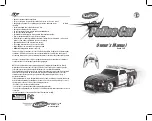
Owner’s Manual
Item # 2411
BROOKLYN, NY 11205
www.kidirace.com
© 2019 KIDIRACE
For Ages
3+
For Ages
3+
SAFETY
• Operate only under adult supervision.
• Select a safe place to operate this car. Never drive on or close to a street.
• Keep fingers, hair and loose clothing away from tires, hubs and motor
while in
operation.
• Avoid operating when controller battery is low.
• Only operate within your line of sight.
• Do not operate in the rain or drive through standing water.
• Do not over charge the battery.
• Packaging should be kept as it may contain important information.
• Non-rechargeable batteries are not to be recharged.
• Different types of batteries (Alkaline, standard - carbon-zinc, rechargeable – nickel-cad-
mium) or new and used batteries are not to be mixed.
• Exhausted batteries to be removed from the toy.
• The supply terminals are not to be short circuited.
• All packaging to be removed before giving to child.
• WARNING: strangulation hazard – long cord.
This device complies with part 15 of the FCC Rules. Operation is subject to the following two
conditions: (1) This device may not cause harmful interference, and (2) this device must
accept any interference received, including interference that may cause undesired operation.
Changes or modifications not expressly approved by the party responsible for compliance
could void the user's authority to operate the equipment.
NOTE: This equipment has been tested and found to comply with the limits for a Class B
digital device, pursuant to part 15 of the FCC Rules. These limits are designed to provide
reasonable protection against harmful interference in a residential installation.
This equipment generates, uses and can radiate radio frequency energy and, if not installed
and used in accordance with the instructions, may cause harmful interference to radio
communications. However, there is no guarantee that interference will not occur in a
particular installation.
If this equipment does cause harmful interference to radio or television reception, which can
be determined by turning the equipment off and on, the user is encouraged to try to correct
the interference by one or more of the following measures:
- Reorient or relocate the receiving antenna.
- Increase the separation between the equipment and receiver.
- Connect the equipment into an outlet on a circuit different from that to which the receiver is
connected.
- Consult the dealer or an experienced radio/TV technician for help.




















